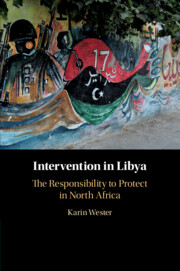Book contents
- Intervention in Libya
- Intervention in Libya
- Copyright page
- Dedication
- Epigraph
- Contents
- Preface
- Maps
- Introduction
- 1 The Origin of the Responsibility to Protect
- 2 Authority Based on Protection in a Historical Context
- 3 Libya and the Era of Qadhafi’s Rule
- 4 The Libyan Uprising and the International Response, February 15–26, 2011
- 5 The Libyan Uprising and the International Response, February 26–March 17, 2011
- 6 Operation Odyssey Dawn
- 7 Operation Unified Protector, NATO, and the UN
- 8 A Divided International Community Confronts a Divided Libya
- 9 Lessons to Be Learned
- Epilogue
- Select Bibliography
- Index
3 - Libya and the Era of Qadhafi’s Rule
Published online by Cambridge University Press: 28 February 2020
- Intervention in Libya
- Intervention in Libya
- Copyright page
- Dedication
- Epigraph
- Contents
- Preface
- Maps
- Introduction
- 1 The Origin of the Responsibility to Protect
- 2 Authority Based on Protection in a Historical Context
- 3 Libya and the Era of Qadhafi’s Rule
- 4 The Libyan Uprising and the International Response, February 15–26, 2011
- 5 The Libyan Uprising and the International Response, February 26–March 17, 2011
- 6 Operation Odyssey Dawn
- 7 Operation Unified Protector, NATO, and the UN
- 8 A Divided International Community Confronts a Divided Libya
- 9 Lessons to Be Learned
- Epilogue
- Select Bibliography
- Index
Summary
This chapter provides a concise overview and analysis of Libya’s recent history, in particular the era of Colonel Qadhafi’s reign, which started with the 1969 revolution. As from this moment on, Libya was dominated and shaped by Qadhafi’s specific brand of revolution at home and anti-imperialistic adventurism abroad. Eventually, major powers were antagonized to such an extent that Libya was treated as a pariah state by the international community. In a remarkable volte-face around the turn of the century, a series of backchannel negotiations between Libya and (primarily) the United Kingdom and the United States resulted in agreements on financial compensation for the Lockerbie victims, Libya’s renunciation of terrorism, and the country’s denouncement of its weapons of mass destruction. After UN, EU, and US sanctions had been lifted, Libya was fully rehabilitated on the world stage, and economic, political, and intelligence relations flourished. However, Libya’s human rights record remained poor, and since the Libyan leadership failed to introduce any meaningful political reforms, domestic oppression continued to persist.
Keywords
- Type
- Chapter
- Information
- Intervention in LibyaThe Responsibility to Protect in North Africa, pp. 61 - 92Publisher: Cambridge University PressPrint publication year: 2020

